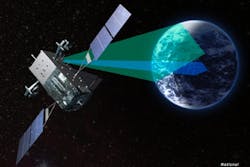Lockheed Martin team encapsulates U.S. Air Force SBIRS GEO-2 satellite in launch vehicle payload fairing
CAPE CANAVERAL AIR FORCE STATION, Fla., 14 March 2013. Space Based Infrared System (SBIRS) Geosynchronous Earth Orbit (GEO-2) spacecraft, built by Lockheed Martin (NYSE:LMT) engineers, has been encapsulated into its payload fairing in preparation for a 19 March 2013 liftoff aboard a United Launch Alliance Atlas V rocket from Cape Canaveral Air Force Station, Fla.
SBIRS GEO-2, thought to be the most technologically advanced infrared surveillance satellite to date, is expected to enhance the nation's missile warning capabilities and improve missile defense, technical intelligence, and battlespace awareness.
The satellite includes sophisticated scanning and staring sensors with improved infrared sensitivity and a reduction in area revisit times over the legacy constellation. The scanning sensor will provide wide-area surveillance of missile launches and natural phenomena across the earth, while the staring sensor will be used to observe smaller areas of interest with superior sensitivity.
The SBIRS program employs a mix of satellites in geosynchronous orbit, hosted payloads in highly elliptical earth (HEO) orbit, and ground hardware and software to deliver timely, reliable, and accurate infrared surveillance information to the President of the United States, the Secretary of Defense, combatant commanders, the intelligence community, and other key decision makers.
Lockheed Martin's SBIRS contracts include four HEO payloads, four GEO satellites, and ground assets to receive, process, and disseminate the infrared mission data. The team has also begun procuring long lead parts for the fifth and sixth GEO satellites. HEO payloads and the first GEO satellite have already launched into orbit.
The SBIRS team is led by the Infrared Space Systems Directorate at the U.S. Air Force Space and Missile Systems Center. Lockheed Martin is the SBIRS prime contractor, Northrop Grumman is the payload integrator. Air Force Space Command operates the SBIRS system.

